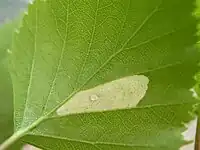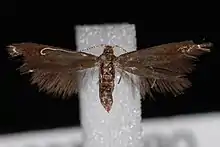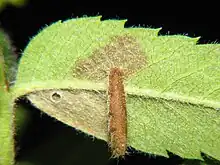Coleophora serratella
Coleophora serratella is a moth of the family Coleophoridae. It is found in Europe (except the Balkan Peninsula), Japan (Hokkaido) and North America.[2]


| Coleophora serratella | |
|---|---|
 | |
| Imago | |
 | |
| Case | |
| Scientific classification | |
| Domain: | Eukaryota |
| Kingdom: | Animalia |
| Phylum: | Arthropoda |
| Class: | Insecta |
| Order: | Lepidoptera |
| Family: | Coleophoridae |
| Genus: | Coleophora |
| Species: | C. serratella |
| Binomial name | |
| Coleophora serratella | |
| Synonyms | |
|
List
| |
Description
The wingspan is 11–14 millimetres (0.43–0.55 in). Coleophora species have narrow blunt to pointed forewings and a weakly defined tornus The hindwings are narrow-elongate and very long-fringed. The upper surfaces have neither a discal spot nor transverse lines. Each abdomen segment of the abdomen has paired patches of tiny spines which show through the scales. The resting position is horizontal with the front end raised and the cilia give the hind tip a frayed and upturned look if the wings are rolled around the body. C. serratella characteristics include head light ochreous - fuscous. Antennae whitish, ringed with fuscous, more faintly or obsoletely towards apex, basal joint fuscous. Forewings rather dark fuscous, ochreous - tinged. Hindwings dark fuscous.[3] Only reliably identified by dissection and microscopic examination of the genitalia.
Life cycle
The moth flies in June depending on the location.
The larvae feed on birches, elms, alders, hazels, apples, Crataegus, Sorbus, willows, Comptonia peregrina and Quercus wislizenii. They create a strongly curved youth case. The adult case is a tubular leaf case. It is trivalved and about 7 millimetres (0.28 in) long. The mouth angle is about 30°. It is straw coloured. Larvae start feeding in September and continue to the end of October. They hibernate in their case, and resume feeding in April.[4]
References
- "Coleophora serratella (Linnaeus, 1761)". Fauna Europaea. 2.6.2. August 29, 2013. Retrieved 12 October 2019.
- "Descriptions Of Nine New Species Of The Genus Coleophora From Japan, With Notes On Other Species (Lepidoptera: Coleophoridae)" (PDF). Hokkaido University.
- Meyrick, E., 1895 A Handbook of British Lepidoptera MacMillan, London pdf
 This article incorporates text from this source, which is in the public domain. Keys and description
This article incorporates text from this source, which is in the public domain. Keys and description - Ellis, W N. "Coleophora serratella (Linnaeus, 1761) common case-bearer". Plant Parasites of Europe. Retrieved 12 October 2019.
External links
 Media related to Coleophora serratella at Wikimedia Commons
Media related to Coleophora serratella at Wikimedia Commons- Coleophora serratella at UKmoths